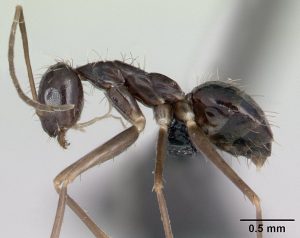Another post in our series Explaining Science – bringing scientific discoveries focused around biodiversity to your living room.
Ants are fascinating creatures, often living in large colonies. Some of you may be familiar with this behavior as a nuisance in your home, e.g. with carpenter ants or fire ants. Ant biology and their way of social living fascinates researchers, and some of the ants’ behavior may be quite similar to what we see in our societies. Just recently a study reported how Gene-Modified Ants Shed Light on How Societies Are Organized. But did you know that these small ants can themselves become hosts for even smaller animals? Mites, in particular species in the genus Macrodinychus, have evolved to parasitize ants. They feast on the content of ant pupae, the larval stages of ants, to nourish their own development. “Vampire mites” is what Dr. Hans Klompen, acarologist and Professor in the department of Evolution, Ecology and Organismal Biology, calls them. By the way, the ant species these mites parasitize is called Longhorn crazy ant, an invasive ant species with a cool name.
Listen to an interview with Dr. Klompen about his recent publication in Scientific Reports “Macrodinychus mites as parasitoids of invasive ants: an overlooked parasitic association” and learn about “a bizarre little group of mites”” that he studies.
How does one find out about mites, often microscopical creatures, living on ants, in particular when you are a researcher based in Ohio while the ants live mainly in the tropics?
How did the project of describing a new mite species evolve into more?
How often do these mites attack ants and which species of ants?
Do the mites attack all different colonies of ants?
So what do we know about the life history of this mite whose developmental stages, its nymphs, feast on ant pupae? Find out more results from Dr. Klompen’s research on these mites in Friday’s post!
***************************************************************
Terms you may want to familiarize yourself with:
Mites are small arthropods, closely related spiders and scorpions, with two body regions, no antennae, and four pairs of legs as adults.
The life cycle of these mites is composed of five active stages: egg, larva, protonymph, deutonymph, and adult
ventral – the underside of an animal, the belly
dorsal – the upper side of an animal, the back
Reference:
 About the Author: Dr. Hans Klompen is professor in the department of Evolution, Ecology and Organismal Biology and director of the Ohio State University Acarology Collection.
About the Author: Dr. Hans Klompen is professor in the department of Evolution, Ecology and Organismal Biology and director of the Ohio State University Acarology Collection.



So very interesting. The ecology of these mite-ant associations looks to be a fertile area for future research. Of course it is very tempting to speculate about whether or not mites are important in the control of potentially new introduced or even invasive species. How much might these tiny parasitoids be determining the failure of some accidental introductions.
Any research out your way on ants being a vector for the varroa mite?